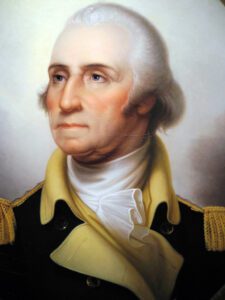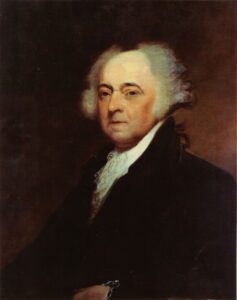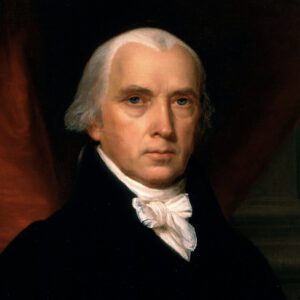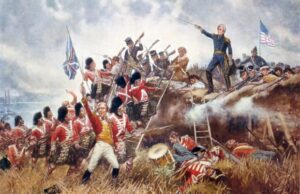The 1783 Treaty of Paris ended the American War for Independence, but it left some important situations unaddressed, and the British generally ignored American sovereignty and international rights. The most significant attempt to address this situation was the 1794 Jay’s Treaty, but it was domestically unpopular because it favored the British. The main value of the Jay Treaty was that it temporarily averted a war that the newly established United States was ill-prepared for. Continued British violations and harassment eventually led to the War of 1812. Winning this war firmly established the sovereignty and identity of the United States of America.
The American Revolutionary War was a world war involving all the world’s major monarchies. Allied with America against Britain were France, Spain, and the Netherlands. Monarchies are not usually big fans of revolts, but the American allies saw the Revolution as an opportunity to weaken Britain. They were concerned that Britain was becoming the most prosperous, powerful, and far-flung empire in the world.
Despite the agreements made in the 1783 Treaty of Paris, the British did not really accept American independence, and like most of the world expected the American experiment in democracy to fail. However, the British knew that peace was desirable to end the excessive costs of a distant war and to rebuild the highly profitable trade with the Americas. They also knew trade would survive if the American government failed because Britain would step in and reestablish their colonial government.

The British illegally maintained forts and military forces in the American fronter and with their Indian allies regularly raided American settlements. In international waters, the powerful Royal Navy harassed American merchant ships. These and other matters were addressed in international negotiations over the years, but the British always outmaneuvered the Americans. The core problem of no British respect of the United States as a sovereign nation was never faced head-on.
In 1793 the British and other European powers found it necessary set aside their differences to ally against France. War with France was nothing new for Britain, but the master of war Nepoleon was another matter. Nepoleon was not defeated until the 1815 epic battle of Waterloo.
For Britain, the Napoleonic wars were expensive and bloody and overlapped the War of 1812 against the Americans. At the start of the European conflict, the United States declared international rights of neutrality, but the British intercepted and seized American merchant ships trading with France and impressed American sailors.
The infant United States of America was like a dwarf among giants. The new nation was militarily and economically weak, had not developed a common identity, and was torn by bitter political partisanship. The Federalists and Antifederalists parties were trying to destroy each other by any means.

President George Washington had warned against political parties and foreign alliances, but politicians had ignored his advice. Washington did, however, provide stability, honor, and order to the first eight years of government. Without Washington there is a good chance that the government would have failed.
The end of the Revolutionary War had been hailed by most Americans because they were tired of war, but the first government under the Articles of Confederation was weak and ineffective. Also, despite the 1788 ratification of the Constitution of the United States, common people were not affected by it much initially.
There was a general feeling of instability and worry about the future among the American people even though some saw the possibilities and were starting what eventually became an economic surge. Common people were mostly uneducated and concerned with everyday problems. They did not think much about the lofty ideals and principles that the founders did. They dealt in survival and the reality of the moment, and information moved slowly, particularly on the frontier.
As previously stated, Americans had not yet developed a national identity, which is necessary for a viable and stable nation. Americans were divided by section, religion, background, and socioeconomic standing. The country was also experiencing a flood of new immigrants. The War had violently pitted Loyalist against Patriot and the scars were slow to heal. Many, especially new immigrants, were moving into the dangerous frontier lured by the promise of cheap land, but they risked conflict with the British and their Indian allies. The new American government was not capable of protecting the settlers.
The British did not live up to the provisions of the Treaty of Paris, but to be fair, neither did the Americans. Despite agreements to honor the rights of Loyalists and to allow them to sue to recover lost property, confiscation of Loyalist property became a cottage industry. Loyalists who had not fled during the war often faced violent acts of revenge.
George Washington was the first President of the United States. He served from 1789 to 1797 when he began a well-deserved retirement. After Washington, politics became bitterly partisan, but each early administration contributed to the development of the America we know today.
The following is a summary of the major accomplishments of the next three administrations to chronicle what was being accomplished leading up to and during the War of 1812.

After a bitter campaign, Washington was succeeded by John Adams of Massachusetts who served one term 1797 to 1801. Adams’ vice president was his major opponent, Thomas Jefferson. At that time the runner-up was elected to that office. This rule was not changed until the 12th Amendment to the Constitution in 1804.
The Adams administration was known for reason, moral leadership, rule of law, compassion, and a cautious but active foreign policy. He led the country through Fries’s Tax Rebellion, and the largely naval Quasi-War with France. He expanded the military and successfully avoided a major war. He signed the controversial Alien and Sedition Act, which was an attack on constitutional rights, particularly free speech.

After another very bitter campaign, Thomas Jefferson defeated John Adams and his party swept the Federalists out of power. Jefferson served two terms as president 1801-1809. He was a wealthy Virginia planter and brought his strong antifederalist views to the office. He believed in a limited central government with most power being vested in the states.
Jefferson was determined to roll back all of Adams’ programs and initiatives. He reduced taxes, government spending, the national debt, and repealed the Alien and Sedition Act. He established the US Military Academy at West Point and sent the small US Navy to confront the Barbary Pirates in the Mediterranean Sea. The important 12th Amendment to the Constitution and the act to prohibit importation of slaves were passed. The Embargo Act of 1807 caused a US depression but did nothing to curtail the European powers. This embargo was repealed the next year.
Jefferson is best known for acquisition of the Louisiana Territory, which essentially doubled the land area of the United States. He also dispatched the Lewis and Clark Expedition to explore and map this vast region and to push all the way to the Pacific Ocean. The Louisiana purchase was negotiated by Secretary of State James Madison and Ambassador to France Robert Livingston for fifteen million dollars.
Unfortunately, Jefferson spent a lot of time during his second term trying to get his former vice president, Aaron Burr, arrested and convicted for murder. His personal involvement in this matter was unconstitutional since he was interfering with the justice system and was demanding conviction without a fair trial. Burr had killed Alexander Hamilton in a duel and was tried three times and acquitted three times, but that did not satisfy Jefferson. He was not a good person to have as an enemy.
Jefferson tried to maintain American neutrality during the European wars but relations with Britain became even more strained as time passed. The Royal Navy was increasing their interference with American trade with France.

The next President, James Madison, served from 1809-1817 and was the hand-picked Jefferson candidate. As Secretary of State, he had protested to both Britain and France about their seizure of American ships, but both had ignored the protest. John Randolph stated the protest had the effect of “a shilling pamphlet hurled against eight hundred ships of war.”
When Madison took office, neither he nor Congress could settle on a foreign policy, and their indecision made matters worse. The British increased ship seizures and impressment of American sailors and increased their support of Indian attacks against Americans on the frontier. Finally, Madison issued a war proclamation against Britain on 18 June 1812.
America was not prepared for war. Congress had not properly organized nor funded a national army. Some states would not support “Mr. Madison’s War” and would not allow their militias to serve. America did have a small, but experienced Navy that had been organized for the Quasi-War with France. Both the British and Americans used Indian allies to augment their numbers.
Despite all the handicaps, Americans attempted to fight off the superior British, but were usually defeated. The war drug on and Madison was reelected despite some of his own party supporting his opponent. Madison was criticized and blamed for the lack of trade with Europe and New England threatened to secede from the Union.

The low point came in August 1814 when the British invaded Washington and burned the President’s House, the Capitol, the Library of Congress, and other buildings. The Madison’s had to flee from the city but returned very soon and began to rebuild. Burning the capitol served to galvanize American resolve and the military responded by being more aggressive against the British.

Both Britain and the US became weary of battle and its costs and agreed to meet in Ghent, United Netherlands (now Belgium) to negotiate an end to the war. The Treaty of Ghent was signed in December 1814 in Europe. Before word could reach America, General Andrew Jackson’s pick-up army dealt the British a humiliating defeat at the Battle of New Orleans on 8 January 1815. Jackson’s victory prevented a British plot to permanently lay claim to New Orleans and possibly to the entire Louisiana Territory.
While far from perfect, the Treaty of Ghent firmly established the United States as a sovereign nation and guaranteed American borders. British troops finally left the American frontier and retreated into Canada or back to Britain. British interference with trade and impressment of sailors ended. International trade flourished. Except for a few minor incidents, Britain and the US have enjoyed close relations for more than two centuries.
The few but key American naval victories and even fewer ground military victories climaxed by the Battle of New Orleans convinced Americans that the war was gloriously successful, and there was a surge of nationalism. The New England Federalists who had threatened secession were so repudiated that Federalism disappeared as a national political party.

After the War of 1812, a small American standing army was organized and trained. The war also resulted in expanded American sea power and American ships of war guarded the coast and the Great Lakes. US Navy men-of-war proudly sailed the seas displaying the stars and stripes and receiving salutes in ports throughout the world.
Once blamed for the errors in the war, Madison was eventually hailed for its triumphs. He oversaw the beginning of the rebuilding of Washington, DC and his wife Dolly reestablished social life in the city. At the end of his administration, the Madison’s retired to their mansion in Orange County, Virginia, and the James Monroe administration took over the reins of government
The War of 1812 was a watershed moment for the United States. Residents of the country became proud Americans who felt they could accomplish anything, and they moved into the frontier pushing west in droves. Louisiana territory was there for those who had the nerve to venture into that vast but dangerous area. Americans were on the march as one people for the first time, and nothing stopped them until they settled the wilderness all the way to the Pacific Ocean. That spirit still inspires Americans to follow their dreams.
